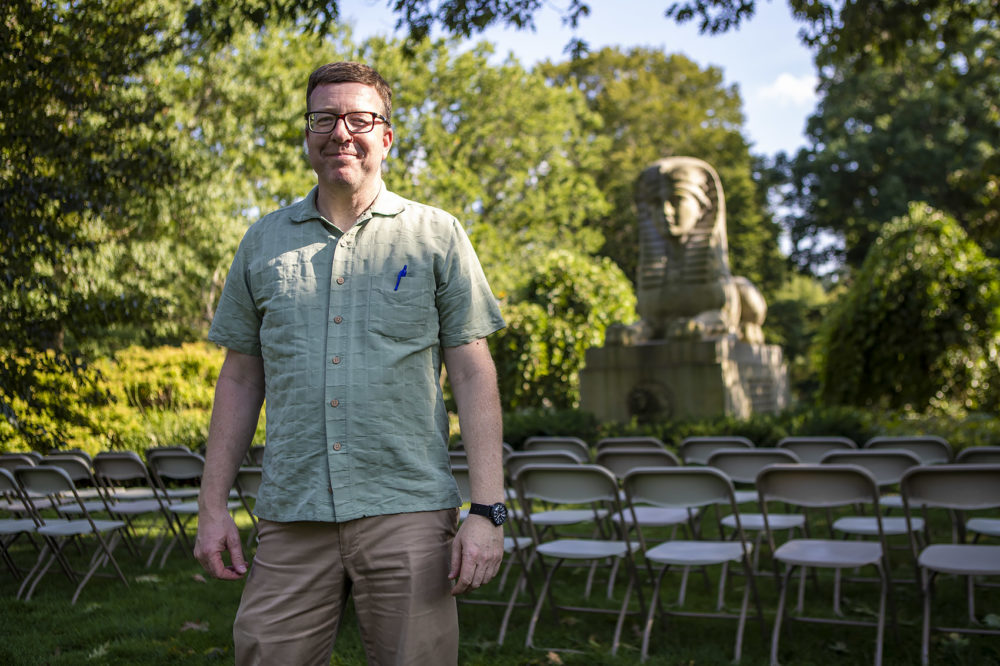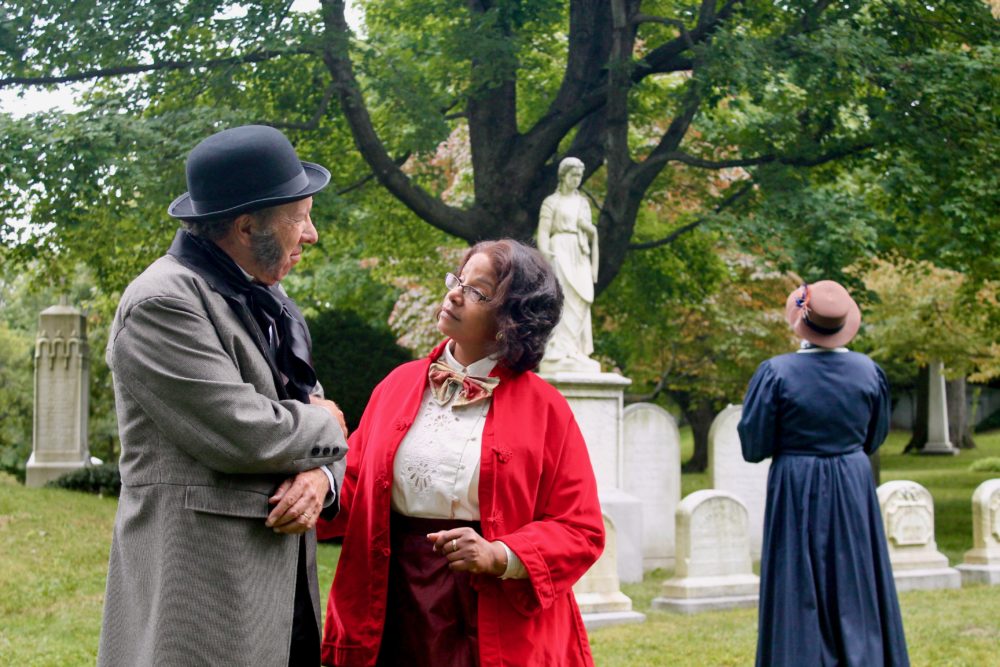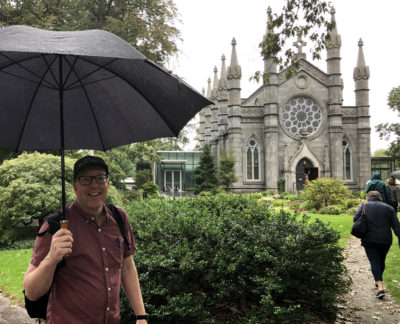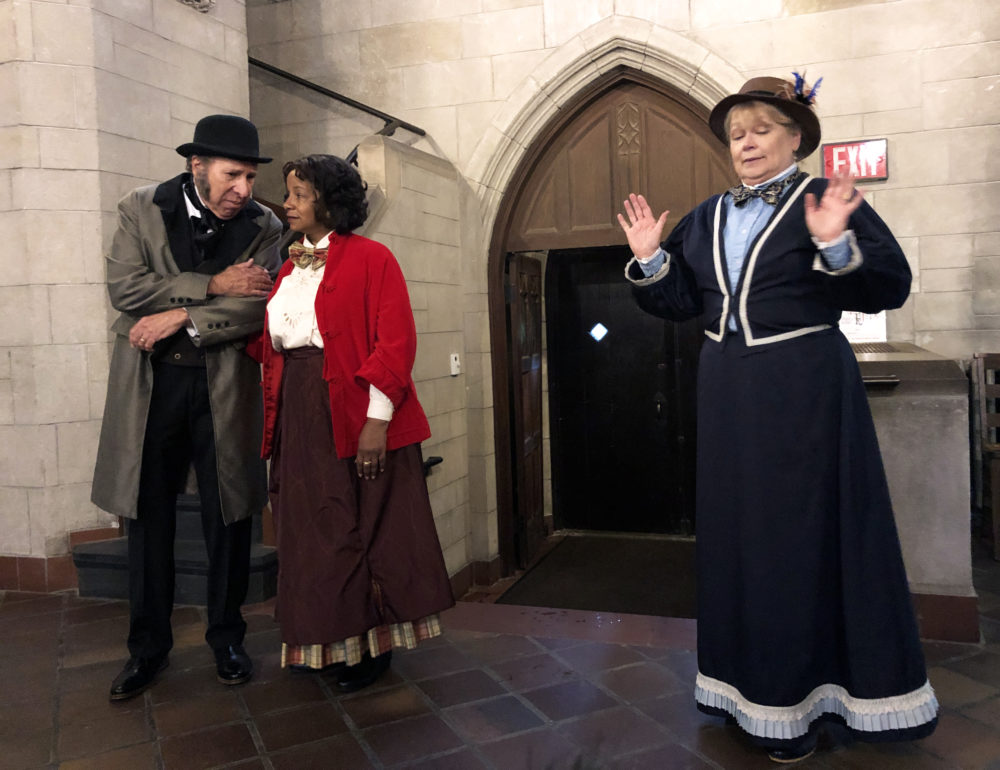Advertisement
What Exactly Is Mount Auburn Cemetery's Artist-In-Residence Digging Up?
ResumeArtists-in-residence are usually invited to brainstorm and create work in museums, universities, galleries and sometimes corporations. But a graveyard?
Yup, Patrick Gabridge has been unearthing history at Mount Auburn Cemetery in Cambridge for the past two years.
If you’re wondering why he’s been hanging around a place where the dead are laid to rest, you are not alone. Gabridge said his family bombarded him with questions about it when he got the gig.
“You're working in a cemetery? What's an artist-in-residence do at a cemetery? Do you live there?” Gabridge recalled with a laugh. “No, I don't live there. My job is to write plays inspired by the things that I find here.”

Gabridge discovered mounds of material walking through the cemetery’s woodsy 175 acres. Founded in 1831, it led the American Victorian-era movement to create contemplative — not creepy — places for the living to commune with the dead in nature. As we strolled along the cemetery’s winding paved paths, Gabridge painted a picture of visitors picnicking while taking in ornate statuary.
“The Museum of Fine Arts doesn't exist until the 1870s. There's no public art museum, there are no public parks,” he explained, “and this place is an interesting, quiet little bombshell that becomes an enormously popular place. It's the most visited place in New England for many years.”
These days, there is more than 100,000 people buried in the cemetery’s lush, landscaped plots. Gabridge spent a lot of time in what he refers to as the “historic core” searching for threads in the spider web of connections between the individuals buried at Mount Auburn.
Gabridge avoided famous residents like Henry Wadsworth Longfellow, Isabella Stewart Gardner, Winslow Homer and Buckminster Fuller. The artist-in-residence wanted characters for his series of short, roving, site-specific plays that would examine the struggles of women, African Americans, immigrants and the notion of American identity after the Civil War.
The playwright chose the cemetery’s architect Jacob Bigelow (1787-1879) as a starting point, in part because his 19th century views on race and gender had the potential to fuel conflict.
As we stopped briefly at Bigelow’s modest headstone, Gabridge said he was eager to find out more.

The cemetery's development director Jenny Gilbert said an artist-in-residence’s fresh, outside perspective examines the founder's Victorian ideas in ways the staff here might not. For her, Gabridge’s five walking plays that cover two miles are an immersive way to encounter the grounds and residents.
“Patrick's written a play about Jacob Bigelow that shows him as a complicated man of his time,” she said.
Gabridge is the cemetery’s third artist-in-residence. Gilbert saw his dramatization of the Boston Massacre in the 2016 play, “Blood On The Snow,” that was staged at Boston’s Old State House and thought he’d be a perfect fit at Mount Auburn. She said history became real through his words via flesh and blood actors. She wanted the same for the cemetery.
Gabridge’s first series of plays premiered in the spring. For Gilbert his five new plays are an immersive vehicle for encountering the grounds and residents.
“You really are able to think in a different way. You're sitting outside, you're watching actors, maybe you'll see a hawk fly by and it's actually a very deep and moving experience at the graves of the people who are talking to you,” she said. “It’s just kind of incredible.”

Beneath graying skies, the audience I tagged along with meets Bigelow in 1872. Not at his grave, but in front of his new, mammoth “American Sphinx” monument to commemorate the Civil War’s end.
“I worry there isn't enough solemnity in the whole world for what this nation has suffered,” Bigelow shares with his wife (played by Sarah Newhouse) and acclaimed Irish Immigrant sculptor Martin Milmore (actor Matt Ryan).
The aging Bigelow (actor Ken Baltin) is blind. He awkwardly climbs a ladder so he can use his hands to assess the artist’s handiwork. Then Bigelow is suddenly able to see a woman, or her ghost. She glares at him then walks past the audience and down a shrubby path.
“What was that?” he asks, clearly agitated. “What is she doing here? Do you see her?”
The apparition was another one of Gabridge’s Mount Auburn discoveries.
“I ended up finding that Bigelow is involved with Harriot Hunt, in that he denied her access to Harvard Medical School in 1847 and 1850,” the playwright said, “and she never forgot and never forgave him.”
Even so, Harriot Kezia Hunt — the nation’s first female physician — bought a plot in Bigelow’s cemetery. For it, she commissioned a carving of Hygeia, the goddess of hygiene, from another pioneering woman. Edmonia Lewis was the country’s first well-known sculptor of African-American and Native American decent.

Lewis (actor Cheryl D. Singleton) and Hunt (actor Karen MacDonald) confront Bigelow in the Gabridge's third play titled, “Variations on an Unissued Apology.” It was written to unfold at Hunt’s grave with Lewis’s sculpture playing a prominent role. But afternoon rain forced the action and audience to take shelter inside Bigelow’s Gothic Revival chapel.
From under his umbrella, Gabridge — who’s also the play’s producer — was relieved to have a plan B in place. After everyone got settled Hunt, Bigelow and Lewis’s words began to fly.
“How could my learning harm anyone?” Hunt implores in the scene.
“I voted to best serve the interests of Harvard Medical School. A female presence would not be conducive to learning, nor would it reflect well upon the woman,” Bigelow defends.
“I remember the word you used: Inexpedient. It was inexpedient for me to attend,” Hunt replies, “I was an inexpedient woman.”
Then Lewis adds, “I might be one too.”

Gabridge said after learning about Hunt and Bigelow’s fraught relationship he wanted so badly for the cemetery’s founder to say he’s sorry.
“And he never would have said it,” Gabridge mused, then laughed, “But I'm a playwright — so, we get to imagine a scene where maybe it gets set right.
Cheryl D. Singleton was cast in the role of Lewis. She said it’s been powerful to play a real character who fought hard to be an independent woman of color artist in the years after slavery was abolished.
“There are several things that haven't changed since she was here,” Singleton said, “and I'm sure that she would be dismayed to learn that many of the fights that we talk about in the piece are still fights that we're having now.”
After the two-hour performance audience member Merle Kummer of Watertown was clearly invigorated. She said it was the most piece of theater she's seen – even if only half was outdoors.
“I can't imagine a better way to understand what place means in history than to have an experience like this,” she said.
“It is the duty of the living to provide for the dead,” actor Robert Najarian declared. Which, in a way, is what Patrick Gabridge is doing at the cemetery, too.
“Sometimes we look back and things seem flattened out by history,” he told me, adding, “These were real people making hard decisions.”
Just like we are today.
“The America Plays” are being performed outside at Mount Auburn Cemetery Thursday, Saturday and Sunday.
This segment aired on September 19, 2019.
